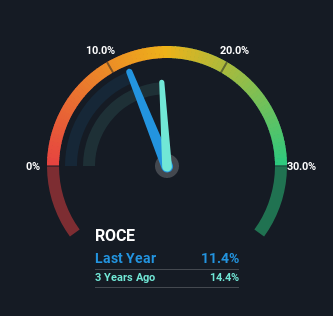- India
- /
- Aerospace & Defense
- /
- NSEI:PARAS
Paras Defence and Space Technologies (NSE:PARAS) Will Want To Turn Around Its Return Trends
If you're not sure where to start when looking for the next multi-bagger, there are a few key trends you should keep an eye out for. Typically, we'll want to notice a trend of growing return on capital employed (ROCE) and alongside that, an expanding base of capital employed. This shows us that it's a compounding machine, able to continually reinvest its earnings back into the business and generate higher returns. In light of that, when we looked at Paras Defence and Space Technologies (NSE:PARAS) and its ROCE trend, we weren't exactly thrilled.
Return On Capital Employed (ROCE): What Is It?
If you haven't worked with ROCE before, it measures the 'return' (pre-tax profit) a company generates from capital employed in its business. To calculate this metric for Paras Defence and Space Technologies, this is the formula:
Return on Capital Employed = Earnings Before Interest and Tax (EBIT) ÷ (Total Assets - Current Liabilities)
0.11 = ₹474m ÷ (₹4.8b - ₹645m) (Based on the trailing twelve months to December 2022).
Therefore, Paras Defence and Space Technologies has an ROCE of 11%. That's a relatively normal return on capital, and it's around the 13% generated by the Aerospace & Defense industry.
See our latest analysis for Paras Defence and Space Technologies

Historical performance is a great place to start when researching a stock so above you can see the gauge for Paras Defence and Space Technologies' ROCE against it's prior returns. If you're interested in investigating Paras Defence and Space Technologies' past further, check out this free graph of past earnings, revenue and cash flow.
What Can We Tell From Paras Defence and Space Technologies' ROCE Trend?
When we looked at the ROCE trend at Paras Defence and Space Technologies, we didn't gain much confidence. Around five years ago the returns on capital were 20%, but since then they've fallen to 11%. On the other hand, the company has been employing more capital without a corresponding improvement in sales in the last year, which could suggest these investments are longer term plays. It's worth keeping an eye on the company's earnings from here on to see if these investments do end up contributing to the bottom line.
On a side note, Paras Defence and Space Technologies has done well to pay down its current liabilities to 13% of total assets. That could partly explain why the ROCE has dropped. Effectively this means their suppliers or short-term creditors are funding less of the business, which reduces some elements of risk. Some would claim this reduces the business' efficiency at generating ROCE since it is now funding more of the operations with its own money.
The Bottom Line
To conclude, we've found that Paras Defence and Space Technologies is reinvesting in the business, but returns have been falling. And in the last year, the stock has given away 16% so the market doesn't look too hopeful on these trends strengthening any time soon. On the whole, we aren't too inspired by the underlying trends and we think there may be better chances of finding a multi-bagger elsewhere.
If you're still interested in Paras Defence and Space Technologies it's worth checking out our FREE intrinsic value approximation to see if it's trading at an attractive price in other respects.
If you want to search for solid companies with great earnings, check out this free list of companies with good balance sheets and impressive returns on equity.
New: Manage All Your Stock Portfolios in One Place
We've created the ultimate portfolio companion for stock investors, and it's free.
• Connect an unlimited number of Portfolios and see your total in one currency
• Be alerted to new Warning Signs or Risks via email or mobile
• Track the Fair Value of your stocks
Have feedback on this article? Concerned about the content? Get in touch with us directly. Alternatively, email editorial-team (at) simplywallst.com.
This article by Simply Wall St is general in nature. We provide commentary based on historical data and analyst forecasts only using an unbiased methodology and our articles are not intended to be financial advice. It does not constitute a recommendation to buy or sell any stock, and does not take account of your objectives, or your financial situation. We aim to bring you long-term focused analysis driven by fundamental data. Note that our analysis may not factor in the latest price-sensitive company announcements or qualitative material. Simply Wall St has no position in any stocks mentioned.
About NSEI:PARAS
Paras Defence and Space Technologies
Designs, develops, manufactures, and tests defense and space engineering products and solutions in India and internationally.
Flawless balance sheet with solid track record.
Similar Companies
Market Insights
Community Narratives




